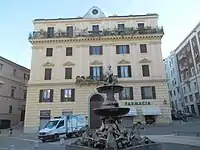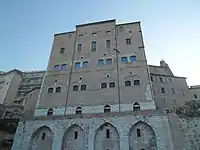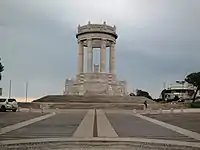Ancona
Ancona (/æŋˈkoʊnə/,[3] also US: /ænˈ-, ɑːnˈ-/,[4][5][6] Italian: [aŋˈkoːna] (![]() listen); Ancient Greek: Ἀγκών, romanized: Ankṓn) is a city and a seaport in the Marche region in central Italy, with a population of around 101,997 as of 2015. Ancona is the capital of the province of Ancona and of the region. The city is located 280 km (170 mi) northeast of Rome, on the Adriatic Sea, between the slopes of the two extremities of the promontory of Monte Conero, Monte Astagno and Monte Guasco.
listen); Ancient Greek: Ἀγκών, romanized: Ankṓn) is a city and a seaport in the Marche region in central Italy, with a population of around 101,997 as of 2015. Ancona is the capital of the province of Ancona and of the region. The city is located 280 km (170 mi) northeast of Rome, on the Adriatic Sea, between the slopes of the two extremities of the promontory of Monte Conero, Monte Astagno and Monte Guasco.
Ancona | |
|---|---|
| Città di Ancona | |
 Aerial view of Ancona | |
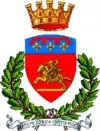 Coat of arms | |
Location of Ancona 
| |
 Ancona Location of Ancona in Marche  Ancona Ancona (Marche) | |
| Coordinates: 43°37′01″N 13°31′00″E | |
| Country | Italy |
| Region | Marche |
| Province | Ancona (AN) |
| Frazioni | Aspio, Gallignano, Montacuto, Massignano, Montesicuro, Candia, Ghettarello, Paterno, Casine di Paterno, Poggio di Ancona, Sappanico, Varano |
| Government | |
| • Mayor | Valeria Mancinelli (PD) |
| Area | |
| • Total | 123.71 km2 (47.76 sq mi) |
| Elevation | 16 m (52 ft) |
| Population (30 April 2015)[2] | |
| • Total | 101,300 |
| • Density | 820/km2 (2,100/sq mi) |
| Demonyms | Anconetani, Anconitani |
| Time zone | UTC+1 (CET) |
| • Summer (DST) | UTC+2 (CEST) |
| Postal code | 60100, 60121–60129, 60131 |
| Dialing code | 071 |
| Patron saint | Judas Cyriacus |
| Saint day | 4 May |
| Website | Official website |
Ancona is one of the main ports on the Adriatic Sea, especially for passenger traffic, and is the main economic and demographic centre of the region.
History



Greek colony
Ancona was populated as a region by Picentes since 6th century BC who also developed a small town there.
Ancona took a more urban shape by Greek settlers from Syracuse in about 387 BC, who gave it its name: Ancona stems from the Greek word Ἀγκών (Ankṓn), meaning "elbow"; the harbour to the east of the town was originally protected only by the promontory on the north, shaped like an elbow. Greek merchants established a Tyrian purple dye factory here.[7] In Roman times it kept its own coinage with the punning device of the bent arm holding a palm branch, and the head of Aphrodite on the reverse, and continued the use of the Greek language.[8]
Roman Municipum
When it became a Roman town is uncertain. It was occupied as a naval station in the Illyrian War of 178 BC.[9] Julius Caesar took possession of it immediately after crossing the Rubicon. Its harbour was of considerable importance in imperial times, as the nearest to Dalmatia, and was enlarged by Trajan, who constructed the north quay with his Syrian architect Apollodorus of Damascus. At the beginning of it stands the marble triumphal arch, the Arch of Trajan with a single archway, and without bas-reliefs, erected in his honour in 115 by the Senate and Roman people.[8]
Byzantine City
Ancona was attacked successively by the Goths and Lombards between the 3rd and 5th centuries, but recovered its strength and importance. It was one of the cities of the Pentapolis of the Exarchate of Ravenna, a lordship of the Byzantine Empire, in the 7th and 8th centuries.[8][10] In 840, Saracen raiders sacked and burned the city.[11] After Charlemagne's conquest of northern Italy, it became the capital of the Marca di Ancona, whence the name of the modern region derives.
Maritime Republic of Ancona
After 1000, Ancona became increasingly independent, eventually turning into an important maritime republic (together with Gaeta and Ragusa, it is one of those not appearing on the Italian naval flag), often clashing against the nearby power of Venice. An oligarchic republic, Ancona was ruled by six Elders, elected by the three terzieri into which the city was divided: S. Pietro, Porto and Capodimonte. It had a coin of its own, the agontano, and a series of laws known as Statuti del mare e del Terzenale and Statuti della Dogana. Ancona was usually allied with the Republic of Ragusa and the Byzantine Empire.
In 1137, 1167 and 1174 it was strong enough to push back the forces of the Holy Roman Empire. Anconitan ships took part in the Crusades, and their navigators included Cyriac of Ancona. In the struggle between the Popes and the Holy Roman Emperors that troubled Italy from the 12th century onwards, Ancona sided with the Guelphs.

Unlike other cities of northern Italy, Ancona never became a signoria. The sole exception was the rule of the Malatesta, who took the city in 1348, taking advantage of the black death and of a fire that had destroyed many of the city’s important buildings. The Malatesta were ousted in 1383. In 1532 Ancona definitively lost its freedom and became part of the Papal States, under Pope Clement VII. The symbol of the new papal authority was the massive Citadel.
In the Papal States
Together with Rome, and Avignon in southern France, Ancona was the sole city in the Papal States in which the Jews were allowed to stay after 1569, living in the ghetto built after 1555.
In 1733 Pope Clement XII extended the quay, and an inferior imitation of Trajan's arch was set up; he also erected a Lazaretto at the south end of the harbour, Luigi Vanvitelli being the architect-in-chief. The southern quay was built in 1880, and the harbour was protected by forts on the heights. From 1797 onwards, when the French took it, it frequently appears in history as an important fortress.
The Greek community of Ancona
Ancona, as well as Venice, became a very important destination for merchants from the Ottoman Empire during the 16th century. The Greeks formed the largest of the communities of foreign merchants. They were refugees from former Byzantine or Venetian territories that were occupied by the Ottomans in the late 15th and 16th centuries. The first Greek community was established in Ancona early in the 16th century.
Contemporary history
Ancona entered the Kingdom of Italy when Christophe Léon Louis Juchault de Lamoricière surrendered here on 29 September 1860, eleven days after his defeat at Castelfidardo.[8]
On 23 May 1915, Italy entered World War I and joined the Entente Powers. In 1915, following Italy's entry, the battleship division of the Austro-Hungarian Navy carried out extensive bombardments causing great damage to all installations and killing several dozen people.[12] Ancona was one of the most important Italian ports on the Adriatic Sea during the Great War.
During World War II, the city was taken by the Polish 2nd Corps against Nazi German forces, as Free Polish forces were serving as part of the British Army. Poles were tasked with capture of the city on 16 June 1944 and accomplished the task a month later on 18 July 1944 in what is known as the battle of Ancona. The attack was part of an Allied operation to gain access to a seaport closer to the Gothic Line in order to shorten their lines of communication for the advance into northern Italy.[13]
Jewish history
Jews began to live in Ancona in 967 A.D.[14] In 1270, a Jewish resident of Ancona, Jacob of Ancona, travelled to China, four years before Marco Polo, and documented his impressions in a book called "The City of Lights". From 1300 and on, the Jewish community of Ancona grew steadily, most due to the city importance and it being a center of trade with the Levant. In that year, Jewish poet Immanuel the Roman tried to lower high taxation taken from the Jewish community of the city. Over the next 200 years, Jews from Germany, Spain, Sicily and Portugal immigrated to Ancona, due to persecutions in their homeland and thanks to the pro-Jewish attitude taken towards Ancona Jews due to their importance in the trade and banking business, making Ancona a trade center. In 1550, the Jewish population of Ancona numbered about 2700 individuals.[15]
In 1555, pope Paul IV forced the Crypto-Jewish community of the city to convert to Christianity, as part of his Papal Bull of 1555. While some did, others refused to do so and thus were hanged and then burnt in the town square.[15] In response, Jewish merchants boycotted Ancona for a short while. The boycott was led by Dona Gracia Mendes Nasi.
Though emancipated by Napoleon I for several years, in 1843 Pope Gregory XVI revived an old decree, forbidding Jews from living outside the ghetto, wearing identification sign on their clothes and other religious and financial restrictions.[16] Public opinion did not approve of these restrictions, and they were cancelled a short while after.[17]
The Jews of Ancona received full emancipation in 1848 with the election of Pope Pius IX. In 1938, 1177 lived in Ancona;[17] 53 Jews were sent away to Germany, 15 of them survived and returned to the town after World War II. The majority of the Jewish community stayed in town or emigrated due to high ransoms paid to the fascist regime. In 2004, about 200 Jews lived in Ancona.
Two synagogues and two cemeteries still exist in the city. The ancient Monte-Cardeto cemetery is one of the biggest Jewish cemeteries in Europe and tombstones are dated to 1552 and on. It can still be visited and it resides within the Parco del Cardeto.
Geography
Climate
The climate of Ancona is humid subtropical (Cfa in the Köppen climate classification) and the city lies on the border between mediterranean and more continental regions. Precipitations are regular throughout the year. Winters are cool (January mean temp. 5 °C or 41 °F), with frequent rain and fog. Temperatures can reach −10 °C (14 °F) or even lower values outside the city centre during the most intense cold waves. Snow is not unusual with air masses coming from Northern Europe or from the Balkans and Russia, and can be heavy at times (also due to the "Adriatic sea effect"), especially in the hills surrounding the city centre. Summers are usually warm and humid (July mean temp. 22.5 °C or 72.5 °F). Highs sometimes reach values around 35 and 40 °C (95 and 104 °F), especially if the wind is blowing from the south or from the west (föhn effect off the Appennine mountains). Thunderstorms are quite common, particularly in August and September, when can be intense with occasional flash floods. Spring and autumn are both seasons with changeable weather, but generally mild. Extremes in temperature have been −15.4 °C (4.3 °F) (in 1967) and 40.8 °C (105.4 °F) (in 1968) / 40.5 °C (104.9 °F) (in 1983).
| Climate data for Ancona (1971–2000) | |||||||||||||
|---|---|---|---|---|---|---|---|---|---|---|---|---|---|
| Month | Jan | Feb | Mar | Apr | May | Jun | Jul | Aug | Sep | Oct | Nov | Dec | Year |
| Average high °C (°F) | 9.2 (48.6) |
10.2 (50.4) |
13.6 (56.5) |
16.9 (62.4) |
21.7 (71.1) |
25.6 (78.1) |
28.2 (82.8) |
28.1 (82.6) |
24.5 (76.1) |
19.4 (66.9) |
13.9 (57.0) |
10.4 (50.7) |
18.5 (65.3) |
| Daily mean °C (°F) | 5.3 (41.5) |
5.9 (42.6) |
8.6 (47.5) |
11.6 (52.9) |
16.3 (61.3) |
20.1 (68.2) |
22.6 (72.7) |
22.7 (72.9) |
19.3 (66.7) |
14.7 (58.5) |
9.8 (49.6) |
6.5 (43.7) |
13.6 (56.5) |
| Average low °C (°F) | 1.4 (34.5) |
1.6 (34.9) |
3.6 (38.5) |
6.4 (43.5) |
10.9 (51.6) |
14.5 (58.1) |
16.9 (62.4) |
17.2 (63.0) |
14.0 (57.2) |
10.0 (50.0) |
5.7 (42.3) |
2.6 (36.7) |
8.7 (47.7) |
| Average precipitation mm (inches) | 43.8 (1.72) |
49.3 (1.94) |
56.8 (2.24) |
58.8 (2.31) |
54.0 (2.13) |
60.4 (2.38) |
47.1 (1.85) |
76.4 (3.01) |
72.6 (2.86) |
75.9 (2.99) |
86.0 (3.39) |
58.1 (2.29) |
739.2 (29.10) |
| Source: MeteoAM[18] | |||||||||||||
Demographics
| Year | Pop. | ±% |
|---|---|---|
| 1174 | 11,000 | — |
| 1565 | 18,435 | +67.6% |
| 1582 | 27,770 | +50.6% |
| 1656 | 17,033 | −38.7% |
| 1701 | 16,212 | −4.8% |
| 1708 | 16,194 | −0.1% |
| 1769 | 23,028 | +42.2% |
| 1809 | 31,231 | +35.6% |
| 1816 | 32,636 | +4.5% |
| 1828 | 36,816 | +12.8% |
| 1844 | 43,217 | +17.4% |
| 1846 | 43,953 | +1.7% |
| 1853 | 44,833 | +2.0% |
| 1861 | 47,230 | +5.3% |
| 1871 | 45,681 | −3.3% |
| 1881 | 48,888 | +7.0% |
| 1901 | 58,602 | +19.9% |
| 1911 | 65,388 | +11.6% |
| 1921 | 68,521 | +4.8% |
| 1931 | 75,372 | +10.0% |
| 1936 | 78,639 | +4.3% |
| 1951 | 85,763 | +9.1% |
| 1961 | 100,485 | +17.2% |
| 1971 | 109,789 | +9.3% |
| 1981 | 106,432 | −3.1% |
| 1991 | 101,285 | −4.8% |
| 2001 | 100,507 | −0.8% |
| 2010 | 102,997 | +2.5% |
| Source: P. Burattini. Stradario – Guida della città di Ancona (Ancona, 1951) and ISTAT | ||
In 2007, there were 101,480 people residing in Ancona (the greater area has a population more than four times its size), located in the province of Ancona, Marches, of whom 47.6% were male and 52.4% were female. Minors (children ages 18 and younger) totalled 15.54 percent of the population compared to pensioners who number 24.06 percent. This compares with the Italian average of 18.06 percent (minors) and 19.94 percent (pensioners). The average age of Ancona resident is 48 compared to the Italian average of 42. In the five years between 2002 and 2007, the population of Ancona grew by 1.48 percent, while Italy as a whole grew by 3.56 percent.[19][20] The current birth rate of Ancona is 8.14 births per 1,000 inhabitants compared to the Italian average of 9.45 births.
As of 2006, 92.77% of the population was Italian. The largest immigrant group came from other European nations (particularly those from Albania, Romania and Ukraine): 3.14%, followed by the Americas: 0.93%, East Asia: 0.83%, and North Africa: 0.80%.
Government
Main sights
Ancona Cathedral


Ancona Cathedral, dedicated to Judas Cyriacus, was consecrated at the beginning of the 11th century and completed in 1189.[21] Some writers suppose that the original church was in the form of a basilica and belonged to the 7th century. An early restoration was completed in 1234. It is a fine Romanesque building in grey stone, built in the form of a Greek cross, and other elements of Byzantine art. It has a dodecagonal dome over the centre slightly altered by Margaritone d'Arezzo in 1270. The façade has a Gothic portal, ascribed to Giorgio da Como (1228), which was intended to have a lateral arch on each side. The interior, which has a crypt under each transept, in the main preserves its original character. It has ten columns which are attributed to the temple of Venus.[8] The church was restored in the 1980s.
Arch of Trajan

The Arch of Trajan is a marble structure 18 metres (59 feet) high, but only 3 metres (9.8 feet) wide, standing on a high platform approached by a wide flight of steps, and is one of the finest surviving Roman monuments in the Marches. It was built in the year 114/115 as an entrance to the causeway atop the harbour wall and is named in honour of Trajan, the emperor who made the harbour. Most of its original bronze ornaments have disappeared. The archway is flanked by pairs of fluted Corinthian columns on pedestals. A pediment bears inscriptions. The format is that of the Arch of Titus in Rome, but made taller, so that the bronze figures surmounting it, of Trajan, his wife Plotina and sister Marciana, would figure as a landmark for ships approaching Rome's greatest Adriatic port.
Other sights
- Lazzaretto: the complex was planned by architect Luigi Vanvitelli in 1732 as a pentagonal building built on an artificial island, also pentagonal, as a quarantine station; it cover more than 20,000 square metres (220,000 square feet), built to protect the city from the risk of contagious diseases eventually reaching the town with the ships. Later it was used also as a military hospital or as barracks; it is currently used for cultural exhibits.
- The Episcopal Palace was the place where Pope Pius II died in 1464.
- Santa Maria della Piazza: medieval romanesque church with an elaborate arcaded façade (1210).[8]
- Palazzo del Comune (or Palazzo degli Anziani – Elders palace); it was built in 1250, with lofty arched substructures at the back, was gotic work of Margaritone d'Arezzo.[8]
- the Palazzo del Governo (now prefecture), Renaissance work of Francesco di Giorgio Martini.[8]
- Santi Pellegrino e Teresa: 18th century church.
- Santissimo Sacramento: 16th and 18th century church.
There are also several buildings by Giorgio da Sebenico, combining Gothic and Renaissance elements: the Palazzo Benincasa, the Loggia dei Mercanti, the Franciscan church of San Francesco alle Scale and Sant'Agostino, Augustinian church with statues portraying St. Monica, St. Nicola da Tolentino, St. Simplicianus and Blessed Agostino Trionfi; in 18th century it was enlarged by Luigi Vanvitelli and turned into a palace after 1860.
The National Archaeological Museum of the Marche Region is housed in the Palazzo Ferretti, built in the late Renaissance by Pellegrino Tibaldi; it preserves frescoes by Federico Zuccari. The Museum is divided into several sections:
- prehistoric section, with palaeolithic and neolithic artefacts, objects of the Copper Age and of the Bronze Age
- protohistoric section, with the richest existing collection of the Picenian civilization; the section includes a remarkable collection of Greek ceramics
- Greek-Hellenistic section, with coins, inscriptions, glassware and other objects from the necropolis of Ancona
- Roman section, with a statue of Augustus, Pontifex Maximus, carved sarcophagi and two Roman beds with fine decorations in ivory[8]
- rich collection of ancient coins (not yet exposed)

The Municipal Art Gallery (Pinacoteca Civica Francesco Podesti) is housed in the Palazzo Bosdari, reconstructed between 1558 and 1561 by Pellegrino Tibaldi. Works in the gallery include:
- Circumcision, Dormitio Virginis and Crowned Virgin, by Olivuccio di Ciccarello
- Madonna with Child, panel by Carlo Crivelli
- Gozzi Altarpiece by Titian
- Sacra Conversazione by Lorenzo Lotto
- Portrait of Francesco Arsilli by Sebastiano Del Piombo
- Circumcision by Orazio Gentileschi
- Immaculate Conception and St. Palazia by Guercino
- Four Saints in Ecstasis, Panorama of Ancona in the sixteenth century and Musician Angels by Andrea Lillio
Other artists present include Francesco Podesti, Ciro Ferri and Arcangelo di Cola. Modern artists featured are Anselmo Bucci, Massimo Campigli, Bruno Cassinari, Enzo Cucchi, Carlo Levi, Aligi Sassu, Orfeo Tamburi and others.
People from Ancona
- Cyriac of Ancona, navigator and archeologist
- Vito Volterra, mathematician
- Virna Lisi, actress
- Franco Corelli, opera singer.
- Angelo Messi, ancestor of famous football star Lionel Messi, emigrated from Ancona to Rosario, Argentina in the 1880s.
Transportation
Shipping
The Port has regular ferry links to the following cities with the following operators:
- Adria Ferries (Durrës)
- Blue Line International (Split, Stari Grad, Vis)
- Jadrolinija (Split, Zadar)
- SNAV (Split) (seasonal)
- Superfast Ferries (Igoumenitsa, Patras)
- ANEK Lines (Igoumenitsa, Patras)
- Minoan Lines (Igoumenitsa, Patras)
- Marmara Lines (Cesme)
Airport
Ancona is served by Ancona Airport (IATA: AOI, ICAO: LIPY), in Falconara Marittima and named after Raffaello Sanzio.
European Coastal Airlines, a former seaplane operator from Croatia, established trans-Adriatic flights between Croatia and Italy in November 2015, and offered four weekly flights from Ancona Falconara Airport to Split (59 minutes) and Rijeka (49 minutes).
Railways
The Ancona railway station is the main railway station of the city and is served by regional and long-distance trains. The other stations are Ancona Marittima, Ancona Torrette, Ancona Stadio, Palombina and Varano.
Roads
The A14 motorway serves the city with the exits "Ancona Nord" (An. North) and "Ancona Sud" (An. South).
Urban public transportation
The Ancona trolleybus system has been in operation since 1949. Ancona is also served by an urban and suburban bus network operated by Conerobus.
International relations
Gallery
See also
- Biblioteca comunale Luciano Benincasa
- History of A.C. Ancona
- Maritime republics
- Roman Catholic Archdiocese of Ancona-Osimo
- Stadio del Conero
- U.S. Ancona 1905
- University of Ancona
References
- "Superficie di Comuni Province e Regioni italiane al 9 ottobre 2011". Istat. Retrieved 16 March 2019.
- "Popolazione Residente al 1° Gennaio 2018". Istat. Retrieved 16 March 2019.
- "Ancona". Lexico UK Dictionary. Oxford University Press. Retrieved 1 August 2019.
- "Ancona". The American Heritage Dictionary of the English Language (5th ed.). Boston: Houghton Mifflin Harcourt. Retrieved 1 August 2019.
- "Ancona". Collins English Dictionary. HarperCollins. Retrieved 1 August 2019.
- "Ancona". Merriam-Webster Dictionary. Retrieved 1 August 2019.
- Silius Italicus, VIII. 438
-
 One or more of the preceding sentences incorporates text from a publication now in the public domain: Chisholm, Hugh, ed. (1911). "Ancona". Encyclopædia Britannica. 1 (11th ed.). Cambridge University Press. pp. 951–952.
One or more of the preceding sentences incorporates text from a publication now in the public domain: Chisholm, Hugh, ed. (1911). "Ancona". Encyclopædia Britannica. 1 (11th ed.). Cambridge University Press. pp. 951–952. - Livy xli. i
- The other four were Fano, Pesaro, Senigallia and Rimini
- The Italian Cities and the Arabs before 1095, Hilmar C. Krueger, A History of the Crusades: The First Hundred Years, Vol. I, ed. Kenneth Meyer Setton, Marshall W. Baldwin (University of Pennsylvania Press, 1955), p. 47.
- Hore, Peter, The Ironclads, London, Southwater Publishing, 2006. ISBN 978-1-84476-299-6.
- Jerzy Bordziłowski (ed. ), Mała encyklopedia wojskowa. Tom 1 (in Polish), Warsaw, Wydawnictwo Ministerstwa Obrony Narodowej, 1967.
- "The Jewish Community of Ancona". The Museum of the Jewish People at Beit Hatfutsot. Retrieved 3 February 2014.
- Ancona Jews#cite note-1
- Edict of the Inquisition of Ancona against the jews at Internet Archive
- Jewish Virtual Library
- "Falconara" (PDF). Italian Air Force National Meteorological Service. Retrieved 5 March 2014.
- "Statistiche demografiche ISTAT". Demo.istat.it. Retrieved 25 March 2013.
- "Statistiche demografiche ISTAT". Demo.istat.it. Retrieved 25 March 2013.
- San Ciriaco – La cattedrale di Ancona, Federico Motta editore, 2003
- "Gradovi prijatelji Splita" [Split Twin Towns]. Grad Split [Split Official City Website] (in Croatian). Archived from the original on 24 March 2012. Retrieved 19 December 2013.
External links
| Wikivoyage has a travel guide for Ancona. |
| Wikimedia Commons has media related to Ancona. |
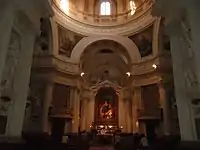
_2017.jpg.webp)







